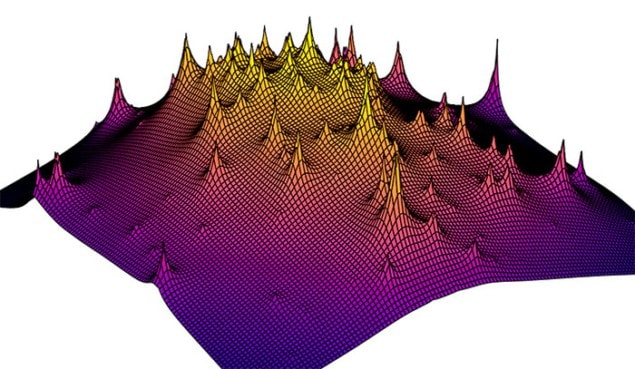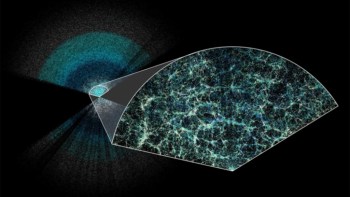Flash Physics is our daily pick of the latest need-to-know developments from the global physics community selected by Physics World‘s team of editors and reporters

New gravitational lensing study backs cold dark matter
A new high-resolution map of dark matter – an invisible substance that appears to have a profound gravitational effect on galaxies and other large-scale structures in the cosmos – has been produced by an international team of astronomers using the Hubble Space Telescope. The map focuses on three galaxy clusters that act as cosmic telescopes by magnifying images of the more distant universe through gravitational lensing. The degree to which this magnification occurs gives an extremely precise measurement of the dark matter within the clusters. “We have mapped all of the clumps of dark matter that the data permit us to detect, and have produced the most detailed topological map of the dark-matter landscape to date,” explains Priyamvada Natarajan of Yale University in the US, who led the team. An important feature of the map is that it is in close agreement with computer simulations of how cold dark matter (CDM) – a popular theoretical description of dark matter – is expected to be distributed within the galaxy clusters. The map is described in the Monthly Notices of the Royal Astronomical Society.
Hard-to-detect skin cancer imaged using Raman spectroscopy
A hard-to-detect pigment in melanoma skin cancer can be imaged using a laser-based technique. A team at Massachusetts General Hospital’s Wellman Center for Photomedicine in the US has used a form of Raman spectroscopy to identify the pheomelanin molecule. Melanoma is the deadliest form of skin cancer and fair skin has a higher probability of developing the hard-to-detect variation of the disease called amelanotic melanoma. This is linked to the fact that fair skin contains a higher concentration of pheomelanin – a pigment, or melanin, within the skin. While the black-brown pigment found in most melanomas is easily observed, pheomelanin is essentially invisible. To detect the pigment, the team, led by Conor Evans, turned to a form of Raman spectroscopy called coherent anti-Stokes Raman Scattering (CARS) microscopy. Raman spectroscopy is a well-known technique that uses lasers to measure the unique chemical vibrations within molecules and hence identify them. CARS microscopy meanwhile, is a high-resolution imaging technique. It focuses two lasers on a sample and “tunes” the energy difference to specific molecular vibrations. This means a high-resolution image can be generated. Using CARS, the researchers successfully imaged the usually invisible pheomelanin by looking for its unique chemical structure. The method could be incorporated into a brand-new tool for early cancer diagnosis. The work will be presented at the OSA Biophotonics Congress: Optics in the Life Sciences meeting on 2–5 April in San Diego, US. It has also been described in Scientific Reports.
Black hole caught “burping” by space telescopes

A connection between the sudden outflows of gas from a supermassive black hole and X-ray bursts has been made by astronomers using two space telescopes – NASA’s NuSTAR and the European Space Agency’s XMM-Newton. Gas outflows are common features of supermassive black holes, which sit at the centre of large galaxies. These objects ingest vast amounts of material and the dynamics of this accretion process can lead to the ejection of gas in a burp-like ultrafast wind. The team trained the instruments on an outflow from the black hole at the centre of galaxy IRAS 13224-3809 and observed that the temperature of an outflow was changing much more rapidly than had previously been seen in other events – on a timescale of less than 1 h. According to team member Erin Kara of the University of Maryland, these fluctuations provide important clues about where the outflow was created. “Because we saw such rapid variability in the winds, we know that the emission is coming from very close to the black hole itself, and because we observed that the wind was also changing on rapid timescales, it must also be coming from very close to the black hole.” The observations were made over several days and revealed that the temperature fluctuations were a response to changes in the intensity of X-rays emitted by the black hole. This information could provide important clues about where the X-rays and outflows are produced. The research is described in Nature.
- You can find all our daily Flash Physics posts in the website’s news section, as well as on Twitter and Facebook using #FlashPhysics. Tune in to physicsworld.com later today to read today’s extensive news story on mimicking the antifogging properties of insect wings.



